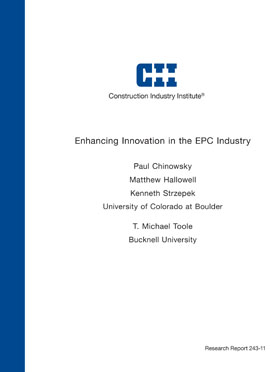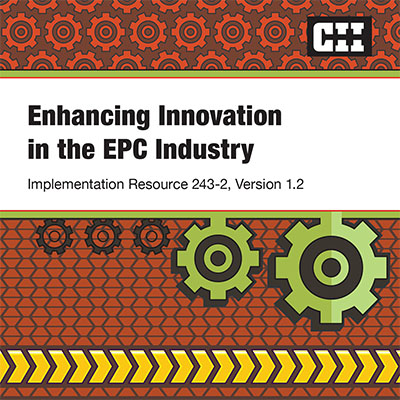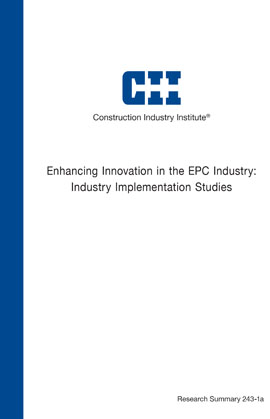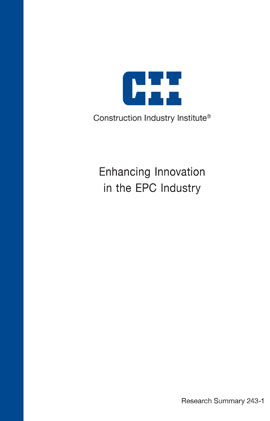
Enhancing Innovation in the EPC Industry
For decades, engineering-procurement-construction (EPC) organizations have given lip service to innovation but secretly pointed at a plethora of factors—all external to their organization—that have kept them from being innovative. But today’s volatile and global markets, today’s ever increasingly complex capital projects and tomorrow’s workforce will no longer allow EPC organizations to ignore opportunities for innovation. CII members who continue to focus solely on achieving short-term project goals at the expense of developing long-term capabilities to manage innovation and change will find themselves following the same path of the U.S. shipbuilding industry: decreasing productivity, decreasing profit margins and decreasing market share.
The results presented in this research report illustrate that the EPC industry has a significant opportunity to improve its innovation performance. Through a literature search, structured interviews and a convenience sample survey of nearly 200 EPC professionals, the research provides empirical evidence that there is a significant gap between what the innovation literature says companies should do to successfully innovate and what most EPC-based firms do. This gap includes all aspects of innovation management as follows:
- Mindset: While EPC firms have a culture that generally affirms the importance of innovation, managers apparently enable innovation only on a project basis. They do not adopt a long-term, multiple-project, risk-tolerant perspective that enables innovation on an organization-wide basis.
- Resources: The vast majority of respondents indicated their companies lack the resources necessary to identify, nurture, track and apply innovations. These resources include expense budgets as well as managing staff to ensure they have sufficient time to nurture innovations.
- Processes and Structure: The innovation literature makes it clear that innovation will rarely happen when managers’ leadership of innovation is passive. Rather, innovation requires genuine leader commitment and an organizational structure and formalized processes that allow employees to methodically identify and evaluate potential innovations, then help effectively implement them on appropriate projects.
- Changed project environments: Successful innovation requires real and sustained commitment by all project entities. Project delivery and contract methods that inhibit collaboration between entities during design and construction, and prevent risk taking, are not conducive to the creative integration needed to innovate.
In response to these findings, RT 243 determined that EPC organizations needed a tool to assess and enhance innovation within their organization. The team created the Innovation Maturity Index, an excel-based survey that asks respondents to evaluate their organization’s capability in each of 61 areas related to innovation. Once the respondents’ data is compiled in a aggregated results spreadsheet, a macro automatically identifies the ten areas in which the organization most needs improvement and provides a brief set of recommendations for improving in each area.
To improve the content and wording of the IMM and confirm it is an effective tool, six EPC organizations were asked to pilot test the tool and provide RT 243 with feedback. Four of the organizations had between 20 and 90 employees take the IMM and reviewed the recommendations for improvement generated by the tool. All four organizations confirmed the wording and content of the IMM were effective in their current form and that the recommendations appeared to be appropriate for their organization. One of these firms implemented the recommendations then had additional employees take the IMM and found statistically significant improvement in the areas that were targeted for improvement. The implementation of the recommendations within the other firms did not occur in time to be discussed in this report.
The IMM data from the four organizations included in this report reveal there is a great level of consistency in the strengths and weaknesses among the case study firms. The common areas requiring greater focus are the areas of Resources and Risk Perspective. Similarly, the common areas of strength found in the organizations are in the areas of Culture and Learning.
The completion of this research effort leads to the overall conclusion that enhancing innovation is an achievable goal for any organization. However, a change in perspective is required that allows the organization to challenge existing assumptions regarding specific areas of operations. The IMM can assist an organization in evaluating these areas and providing the recommendations required to initiate an innovation enhancement initiative.



